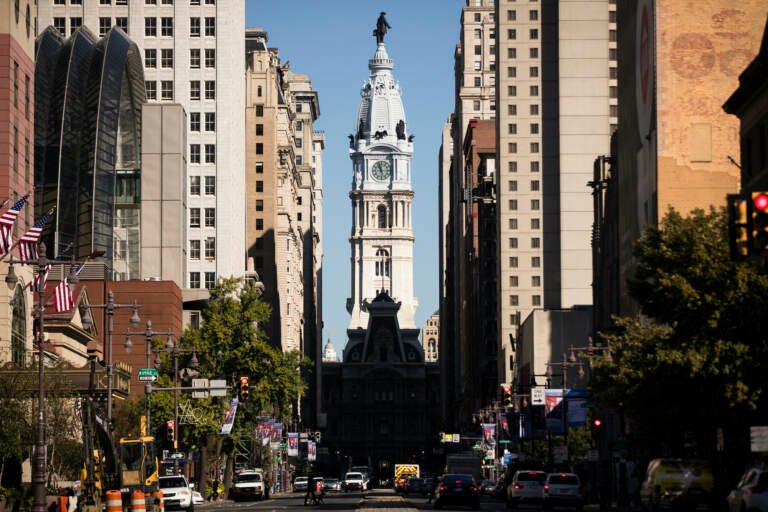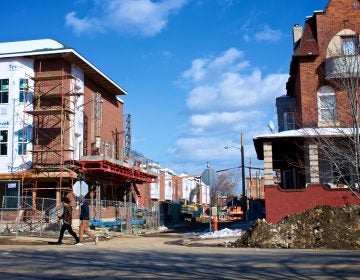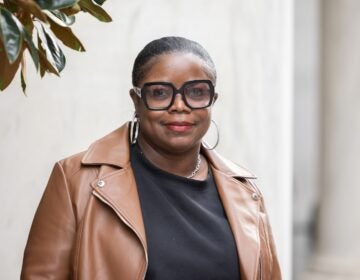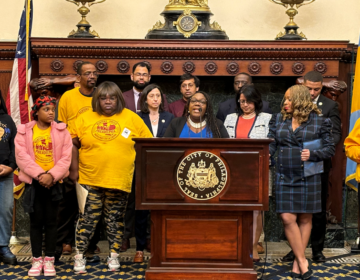Everything you need to know about Philly City Council redistricting
The process was notoriously fraught in 2001, and the end result was considered a gerrymander. This year, onlookers are not expecting fireworks, but have concerns.

City Hall in Philadelphia is seen, Wednesday, Oct. 18, 2017. (AP Photo/Matt Rourke)
Philadelphia City Council is about to start its once-a-decade process for redrawing the lines of its district map. Although redistricting has been tumultuous in the past — and one year, ended with a five-month impasse and a council member going to prison — this time around, the process is expected to be relatively chill.
Pat Christmas, policy director at the Committee of Seventy, which is closely monitoring the process, says that’s largely because the current map, drawn in 2011, is already seen as compact, contiguous, and fair, and he doesn’t expect council to make a lot of radical changes.
“I think a lot of Philadelphians will probably be OK with where the boundaries are,” he said. “And so a lot of the public feedback may actually be quite affirmative.”
But that doesn’t mean redrawing will be without challenges.
Council members have a lot of power over how land is used in Philly, and so the specific borders of their districts could make a difference in how certain parcels and projects are treated — potentially a matter of significant political and public interest. The city’s population has also grown and evolved over the past decade, creating new ethnic enclaves. Mapmakers wanting to avoid cracking them apart and diminishing their shared electoral power, or doing the same by packing them too tightly into one district, will need to be sensitive to the shifting lines.
Another underlying issue is that Philadelphia has few rules for how districts should be drawn, and little mandate for transparency.
“When the redistricting process starts, it tends to be closed and not accessible,” Christmas said. “This has never been a robust and open and accessible public engagement process the way I think a lot of us would like us to see — with public hearings across the city, listening sessions, a preliminary map put out there for people.”
How the process works
Philly’s redistricting rules aren’t complicated. Once council receives census data, members have six months to draw a new map, pass the draft as a piece of legislation, then get the mayor to sign off. If the mayor and council disagree, 12 or more members can override a veto.
The only official criteria the Philadelphia Home Rule Charter gives are that the map must “consist of a ward or contiguous wards containing as nearly as possible the population factor obtained by dividing the City’s population at the preceding decennial census by ten.” That just means all the districts have to be connected, there must be 10 of them, and all must have roughly the same number of people in them. Generally, a population deviation of 10% or less is considered close enough in local redistricting.
Once council submits a draft map, the mayor can either accept or veto it. If the two camps can’t come to an agreement by the six-month deadline, the pressure on council gets turned up: their paychecks are withheld until a deal is struck.
This year’s process already looks a little different than recent years thanks to pandemic-induced census delays.
In both 2001 and 2011, council received the population data they needed on March 9, and their six-month deadline was in September. This year, members didn’t get any data at all until Aug. 12 — and even then, it was in what’s known as a “legacy format,” which was difficult to convert into the granular population data needed. More user-friendly data didn’t arrive until Sept. 16. Still, the clock started ticking in August, so now members have until Feb. 12 to finish the next map.
On the state level, where lawmakers are charged with redrawing state legislative and congressional maps, the census delays could cause real timing problems because lawmakers need to finish the districts in time for nomination petitions to begin circulating for 2022 races. There’s not quite so much pressure in Philly, because its next round of council races isn’t until 2023.
What has gone wrong in the past?
The 2001 round of redistricting was the most notoriously messy in Philadelphia’s recent memory — and led to an infamous map.
Among the main hang-ups in the drawing process was how to group the city’s growing Latino population in the lower Northeast, as well as which districts should have large chunks of Center City, a base for wealthy, potential political donors. These conflicts got wrapped into a complicated web of political clashes over budgeting and blight remediation, and led to a battle of wills.
Ultimately it took council and Mayor John Street — then in his first term and powerful enough to whip council members to his side and keep the body too divided to overrule him — three separate tries, and an extra five months to pass a map.
Council members went without pay for those five months. One, Rick Mariano, was later convicted of taking bribes to pay his credit card bills during that time, and went to prison.
The map they produced was visibly, egregiously gerrymandered. Two districts, the 5th and the 7th, featured long tails that wound north from the bulk of the districts for miles.
The analytics company Azavea conducted a study on redistricting and, using several measures of contiguity, found that map to have one of the most gerrymandered city-level districts in the country.
Ten years later, the 2011 redistricting fixed a lot of those problems and produced much more reasonable-looking districts. That generally noncontroversial map gives council and Mayor Jim Kenney a much easier jumping-off point, Christmas says, but there are still a few areas of tension he’s watching.
Things to watch in 2021
Apart from keeping the process transparent and making sure no specific ethnic groups get disenfranchised, there are two main areas where Christmas thinks special attention is warranted: land use, and funky geographic decisions.
The land-use question has gotten more complicated since the last round of redistricting. Council has imposed four district-specific zoning overlays — across the 4th, 5th, 8th, and 9th districts — and because that kind of bespoke building requirement has never before been in place over entire districts during a round of redistricting, it’s unclear if the requirements will simply conform to new district lines, stay within the old district, or become moot.
“Especially in those communities that are changing, or are close to areas that are changing, land use decisions are a big part of this,” said Christmas. “And for example, if there’s a neighborhood or community that split across two or three different districts, they will have a more difficult time advocating for the sort of development or the sort of changes or lack thereof in the community that they may want to see.”
Then, there’s the question of a few geographic quirks in the old map — particularly one of its most notable anomalies, a small peninsula that juts eastward from the 5th District, represented by Council President Darrell Clarke, who lives within the carve-out.
“There’s no other reason for that extension to be there,” Christmas said.
This year’s drawing hasn’t gotten started in earnest yet. So far Clarke, who will have considerable power over the process and isn’t expected to clash with Kenney over many of the particulars, hasn’t given a timeline.
But many of the political considerations, like protecting incumbents and drawing districts around their addresses, may hold less sway than they usually do. Of the ten members who represent districts, several may leave office before the new districts kick in. The other seven — who do get a say on the map — represent the whole city at large.
Maria Quiñones-Sánchez and Cherelle Parker are both considered likely 2023 mayoral candidates, and would have to resign from council in order to run. Two others, Bobby Henon and Kenyatta Johnson, are facing corruption charges. And aside from usual questions about reelection, there’s also the specter of retirement for long-serving members like Clarke.
Kenney also isn’t envisioning much tumult. Through a spokesperson, he told The Philadelphia Inquirer that he has “minimal changes” in mind.

Get more Pennsylvania stories that matter
WHYY is your source for fact-based, in-depth journalism and information. As a nonprofit organization, we rely on financial support from readers like you. Please give today.









